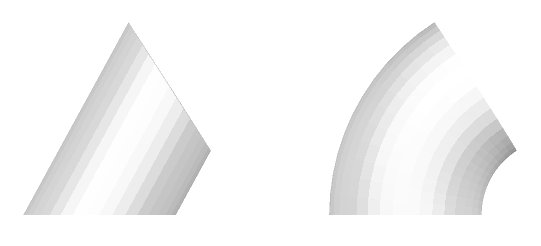subdiv
Ensures a mesh solid exhibits a certain maximum edge length.
Signatures
- subdiv( float maxlen )
- subdiv( float maxlen, vector v1 )
- subdiv( float maxlen, vector v1, vector v2 )
Details
The subdiv modifier checks whether the absolute length (constructor (1)) or the projected lengths onto vectors v1 and/or v2 (constructor (2) and (3)) of the edges of a solid mesh are equal or shorter than maxlen. If this is not the case for some edges, these triangles get subdivided to fulfil the condition.
A finer mesh may be useful for operations like bending that transform the vertices of a solid's mesh in a non-linear way. If the resolution is not fine enough this may lead in unexpectedly "edgy" results. The following example compares a bending with and without the application of subdiv:
Example
modifier bend = bending( 1.0, <[1.0, 0.0, 0.0]>, <[0.0, 0.0, 0.0]>, <[0.0, 0.0, 1.0]> )
make translation( <[0.0, 0.0, 0.0]>) >>
bend >> cylinder()
make translation( <[0.0, 2.0, 0.0]>) >>
bend >> subdiv( 0.1, <[0.0, 0.0, 0.1]> ) >> cylinder()

Bending of a cylinder primitive without (left) and with (right) previous application of a subdiv modifier.
The modifier does not affect the solid's shape but its Tesselation.
Note
The resulting mesh may not be isomorphic to the original one.
Example
make subdiv( 0.5 ) >> box()
Casts To
Parameters
- maxlen
-
The absolute or projected maximum length the edges of the triangles of the mesh solid the modifier is applied to will have.
- v1
-
Defines one projection direction for the edge comparison.
- v2
-
Defines another projection direction for the edge comparison.
